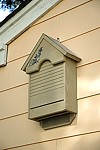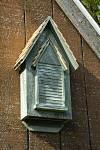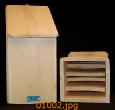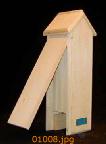
   |
 |
|
|
|
Living with Bats Bats are in serious decline nearly everywhere. Worldwide, there are almost a thousand different kinds of bats which comprise nearly 1/4 of all mammal species. Of the 43 species living in the U.S. and Canada, nearly 40 percent are endangered or are candidates for such status. The biology and ecology of bats is not well understood. Their nocturnal behavior, inaccessible breeding and roosting sites and migratory behavior have made them difficult to study. As a result, we know little of bat ecology or management needs on public lands. Despite a lack of knowledge, we do know that bats often use trees, cliffs, caves, human dwellings, natural waters and water developments, bridges and mine shafts in a variety of habitats. There are clearly opportunities to begin specific management actions to protect or enhance this diverse and threatened group of mammals. Putting up a bat house is one of the more rewarding ways to help wild life. By providing bats with a roosting habitat, you also benefit by having fewer yard and garden pest like mosquitoes and ants. It may seem like just a drop in the bucket but we can over come chemical pest control and create a cleaner heather environment. Bat houses may be put up at any time of the year. They will more than likely be occupied in the first three to four weeks after they have been installed. Installing a bat house and exposing it to the rain and sun will darken the color even more increasing the chances of attracting bats to you bat house just that much better. Although most folks believe bats live in caves, which they do, more than likely they live in old houses or barns where it is warm. With an increase in individual chambers in these bat houses we have found that we could achieve a much better control of the temperature. By doing this we also increased the ability of the box to hold more bats in a more comfortable environment. They could be in your back yard catching all those insects like disease carrying Mosquitoes, that have a way ofspoiling your favorite BarBQ. America's Bats are an invaluable natural resource. Yet due to decades of unwarranted human fear and persecution, bats are in alarming decline. By putting up a bat house, you can help increase the population. Even the most abundant bats of North America are rapidly losing roosting habitat. Bat houses are the answer. Putting up bat houses and making careful observations offer an excellent opportunity to learn more about bat roosting requirements. They can also make a great science project for the school. Bat House BasicsBat House Design.
You should consider design when selecting your bat house.
According to research, larger bat houses (often called nursery houses) have
higher occupancy rates than the smaller houses. All landing areas and partition
surfaces should be rough. Vents are often best where average July temperatures
exceed 85 degrees Fahrenheit. Habitat
Your bat house should be placed within 1/4 mile of a
natural water source such as a stream, river, or lake. Bats tend to fly along
forest or water edges, and bat houses located here tend to be found more quickly
than other locations. Mounting
You may place your bat house on a tree, pole, or a
building; however, boxes mounted on poles or buildings tend to have a higher
occupancy than those mounted on trees. For mounting on buildings, wood or stone
buildings are best, and your bat house should be mounted under the eaves with
some sun exposure. You should mount your house 15-20 feet above the ground. It
should not be in a place lit by bright lights. Sun
Exposure
You should place your bat house where it will receive at
least six hours of sun if you live in a region where average July temperatures
range from 80-100 degrees Fahrenheit. If you live in a region where average July
temperature are less than 80 degrees Fahrenheit, you should mount your bat house
where it will receive at least 10 hours of sun. Timing
You may mount your box at any time of the year, but those
put up in the spring are often occupied more quickly. If you are evicting a
colony of bats from a building, a box should be mounted several weeks prior to
the eviction.
|
 Bat House
Bat House
Description: 7/8" Inland Red Cedar for long lasting outdoor use. All screwed construction using weather-resistant plated deck screws and fully routed edges. Constructed in accordance with "The Bat House Builders Handbook" Dimensions: 16-3/4" L x 4" W x 28-3/4" H  |
 Heartwood Bat Haven
Heartwood Bat Haven
Did you know that many bats eat their weight in insects at night? These valuable creatures provide a great service to our eco-system. It's only right that we provide them with a haven like this: Warm, watertight, with galvanized, corrugated roof, two mesh-covered living quarters and bottom landing pad. Room for up to 48; metal bat applique gives a cheery welcome! Dimensions: 5" x 14" x 22"  |
 Heartwood Victorian Bat House
Heartwood Victorian Bat House
Forget the myth: bats aren't blind; they enjoy the use of all five senses. Another sense--the sense of style, both the bats and yours--will be delighted by this Victorian gem. Horizontal siding on the front panel provides a strategic counterpoint to steeply pitched hand-shingled cypress roof with copper trim. Divided living quarters and a landing pad at the base make this house as functional as it is beautiful. Ready to mount on a pole, building or tree. Dimensions: 6" x 15" x 30"  |
 Recycled Bat House
Recycled Bat House
Description: Large bat house is constructed out of dark brown recycled poly-lumber for warmth. Lifetime warranty. Dimensions: 13-1/2" X 2-3/4" X 27-1/2"   |
 Coveside "BAT" Chelor Pad
Coveside "BAT" Chelor Pad
Houses up to 30 bats in a single chamber. Features include a large screened landing pad, roughened interior surface and an echolocation slot. Designed for cooler locations preferred by solitary males, but also suitable for a small nursing colony. (20"h x 10"w x 3"d) |
 Coveside Bat Beacon
Coveside Bat Beacon
This easy-to-mount bat house is designed to fit on a standard purple martin pole. With three chambers and an attic, it provides an ideal free-standing habitat for establishing a bat colony. Have any bats taken up residency? The purple martin pole makes lowering easy and the side opens for convenient inspection.(25"h x 8"w x 7-1/2"d) |
 Coveside Bat Condominium
Coveside Bat Condominium
This best seller accomodates over 50 bats and is ideal for a nursing colony. The vertical house contains 4 chambers and can be easily mounted by a hanger on a building or a tree. (19"h x 9-1/2"w x 7-1/2"d) |
 Coveside Bat House Kit
Coveside Bat House Kit
This top seller features a single chamber which will hold up to 20 bats. Similar in design to the "BAT"chelor Pad, but smaller. Features an extended landing pad and an interior covered with screening to provide bats with a maximum foothold. Also includes echolocation slot to help the bats locate the cavity. Designed to be an educational tool for youngsters, and adults alike. It comes with easy-to-follow instructions and information about bats. (16"h x 8"w x 3-3/4"d) |
 Coveside Bat Mansion
Coveside Bat Mansion
Houses several hundred bats in five chambers plus an attic, which provides for greater temperature stability. Bats seek most comfortable temperture by moving up or down inside the house. A popular house because of its large capacity. (25"h x 11"w x 11"d) |
 Coveside Bat Tower
Coveside Bat Tower
Latest research indicates that the most successful bat houses are mounted on buildings or are free-standing. The innovative bat tower mounts directly on a 4x4 post. The post actually becomes the landing platform, and from there bats climb into the house. The four internal chambers and attic provide for multiple roosting opportunities. In addition, the side opens to quell the curiosity of the serious "bat-o-phile." (Picture shows house with door partially opened.). (23"h x 6-3/4"w x 7"d) |
 Coveside Large Sunshine's Bat House
Coveside Large Sunshine's Bat House
This special house was designed by Amanda Lollar, who rescued and rehabilitated a little bat named "Sunshine" and then wrote a book about her. Her field testing of many of these houses indicates that bats are readily attracted to and occupy this style. With two chambers and an open slot at the bottom, this abode is suitable for all species of small, insectivorous bats. Features include a screened landing platform, roughened interior surface and echolocation slots on the sides to help bats locate the hollow cavity. Can accomodate 100, 200 or 300 in three different sizes (small, medium and large). (18"h x 24"w x 6-1/2"d) |
 Coveside Mini Bat House
Coveside Mini Bat House
House a few bats in this small version of the "BAT"chelor Pad. Comes complete with echo-location slot and screening against the back. (16"h x 8"w x 3-3/4"d) |
 Coveside Small Sunshine's Bat House
Coveside Small Sunshine's Bat House
This special house was designed by Amanda Lollar, who rescued and rehabilitated a little bat named "Sunshine" and then wrote a book about her. Her field testing of many of these houses indicates that bats are readily attracted to and occupy this style. With two chambers and an open slot at the bottom, this abode is suitable for all species of small, insectivorous bats. Features include a large, screened landing platform, roughened interior surface and echolocation slots on the sides to help bats locate the hollow cavity. Can accomodate 100, 200 or 300 in three different sizes (small, medium and large). (18"h x 14"w x 6-1/2"d) |
|
Ads by Google |

Home
Page |
Product Review Page | Help
 Woodside Gardens
The Registry of Nature Habitats
Woodside Gardens
The Registry of Nature Habitats 
 1999 -
1999 -
All Rights Reserved
Last Updated: